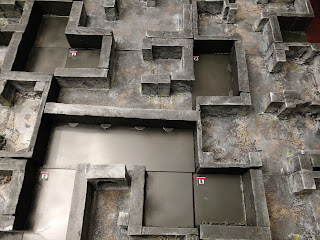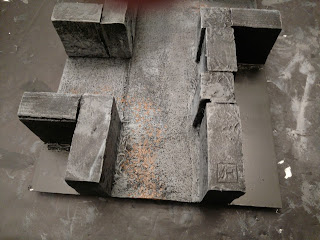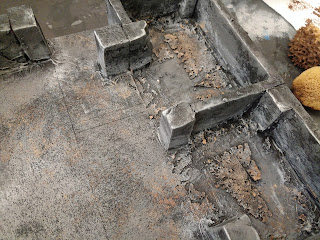Link to Part III-F
Overview
Here's where I go into my cache of half-finished terrain elements and paint them! Dunjon of Death has been in planning for at least 2 years, if not earlier ... and I've got lots of stuff to lay out.
The General Plan
Essentially I'll paint them the same as the others:
- Base coat of black paint plus clear Elmer's glue. Good news; inexpensive. Bad news; if you get it wet, the glue (and paint!) comes off. Good news; you shouldn't be getting any of your terrain or figurines wet any time soon ... right? No coffee or beer on or near the gaming stuff.
- Afterwards, I'll dry-brush with dark grey using a 2-inch brush. Mostly top to bottom strokes.
- Next, I'll dry-brush with medium-gray using a 0.75-inch brush. Mostly pulling from the bottom near the tile floor upwards to about mid-height.
- Using the same brush and paint, I'll dry-brush from the top down to make details pop.
- Lastly, using light gray or white, I'll dry-brush the edges of edge terrain element to make them pop out.
The Terrain
Here's what I've started with;
 |
| All the things. |
 |
| Coat of black + PVC glue. |
 |
| Dry-brush with dark gray. |
 |
| Awaiting the medium gray. |
Everything is Done
Here's everything painted.
 |
| Left side of my table are the recent terrain items. |
 |
| On the right side of the table are my doors from earlier posts. Remember that these are Zombicide and Dungeon Saga doors. |
 |
| A Reaper Bones Skeleton Swordsman next to the Central Blocks. These blocks are about 3 by 2 by 2-inches. |
 |
| Dude next to one of the Cornice Pillars. I have a bunch of cake-shop Greek pillars that I'll need to eventually set up as well. |
 |
| I've got three stair cases and two stair bases. I just noticed that the fights are all right-winding. And so I'll create some later; maybe a straight stair case, and two L-shaped left-winding. |
 |
| The Dungeon Saga and Zombicide doors. These behind the Celt are my "Damaged" doors. |
 |
| OK. And finally the skeleton warrior next to the single-doors; these are both Zombicide doors. |
Inventory
Here's my inventory for the curious.
- 14 Passage Ways (wall with a hole, no door)
- 19 Single Doors (that's Zombicide)
- 3 Double Doors
- 1 Double Door, broken
- 3 Great Doors, unmoving (that's Dungeon Saga)
- 1 Single Gate, jammed.
- 3 Stair cases, right-winding.
- 2 Stair bases (single short flight).
- 8 Wall sections.
- 2 Fallen stella.
- 6 Wall Blocks (4 plain, 2 crowned)
- 6 Central Blocks
- 7 Cornice Pillars
- Plus ... 25 modular Dunjon of Death tiles (22 square, 3 start/exit which are rectangluar).
What's Next
I'll show you everything I've got put together.












































